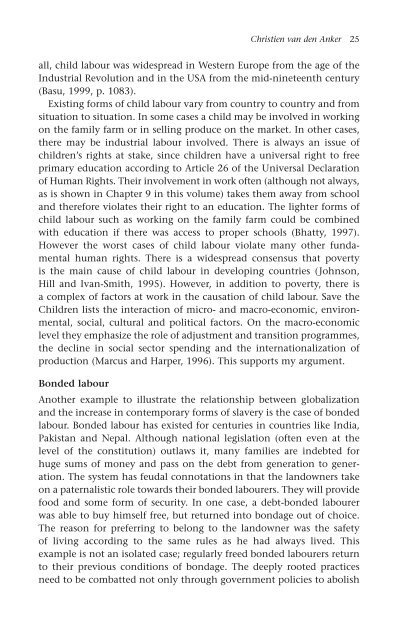3071-The political economy of new slavery
3071-The political economy of new slavery
3071-The political economy of new slavery
You also want an ePaper? Increase the reach of your titles
YUMPU automatically turns print PDFs into web optimized ePapers that Google loves.
Christien van den Anker 25<br />
all, child labour was widespread in Western Europe from the age <strong>of</strong> the<br />
Industrial Revolution and in the USA from the mid-nineteenth century<br />
(Basu, 1999, p. 1083).<br />
Existing forms <strong>of</strong> child labour vary from country to country and from<br />
situation to situation. In some cases a child may be involved in working<br />
on the family farm or in selling produce on the market. In other cases,<br />
there may be industrial labour involved. <strong>The</strong>re is always an issue <strong>of</strong><br />
children’s rights at stake, since children have a universal right to free<br />
primary education according to Article 26 <strong>of</strong> the Universal Declaration<br />
<strong>of</strong> Human Rights. <strong>The</strong>ir involvement in work <strong>of</strong>ten (although not always,<br />
as is shown in Chapter 9 in this volume) takes them away from school<br />
and therefore violates their right to an education. <strong>The</strong> lighter forms <strong>of</strong><br />
child labour such as working on the family farm could be combined<br />
with education if there was access to proper schools (Bhatty, 1997).<br />
However the worst cases <strong>of</strong> child labour violate many other fundamental<br />
human rights. <strong>The</strong>re is a widespread consensus that poverty<br />
is the main cause <strong>of</strong> child labour in developing countries (Johnson,<br />
Hill and Ivan-Smith, 1995). However, in addition to poverty, there is<br />
a complex <strong>of</strong> factors at work in the causation <strong>of</strong> child labour. Save the<br />
Children lists the interaction <strong>of</strong> micro- and macro-economic, environmental,<br />
social, cultural and <strong>political</strong> factors. On the macro-economic<br />
level they emphasize the role <strong>of</strong> adjustment and transition programmes,<br />
the decline in social sector spending and the internationalization <strong>of</strong><br />
production (Marcus and Harper, 1996). This supports my argument.<br />
Bonded labour<br />
Another example to illustrate the relationship between globalization<br />
and the increase in contemporary forms <strong>of</strong> <strong>slavery</strong> is the case <strong>of</strong> bonded<br />
labour. Bonded labour has existed for centuries in countries like India,<br />
Pakistan and Nepal. Although national legislation (<strong>of</strong>ten even at the<br />
level <strong>of</strong> the constitution) outlaws it, many families are indebted for<br />
huge sums <strong>of</strong> money and pass on the debt from generation to generation.<br />
<strong>The</strong> system has feudal connotations in that the landowners take<br />
on a paternalistic role towards their bonded labourers. <strong>The</strong>y will provide<br />
food and some form <strong>of</strong> security. In one case, a debt-bonded labourer<br />
was able to buy himself free, but returned into bondage out <strong>of</strong> choice.<br />
<strong>The</strong> reason for preferring to belong to the landowner was the safety<br />
<strong>of</strong> living according to the same rules as he had always lived. This<br />
example is not an isolated case; regularly freed bonded labourers return<br />
to their previous conditions <strong>of</strong> bondage. <strong>The</strong> deeply rooted practices<br />
need to be combatted not only through government policies to abolish


